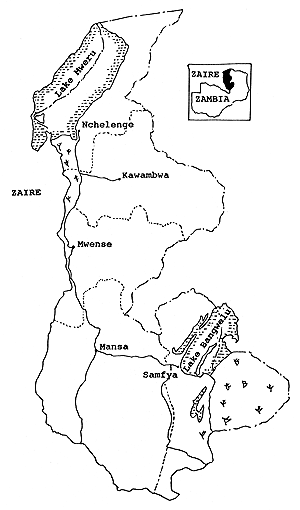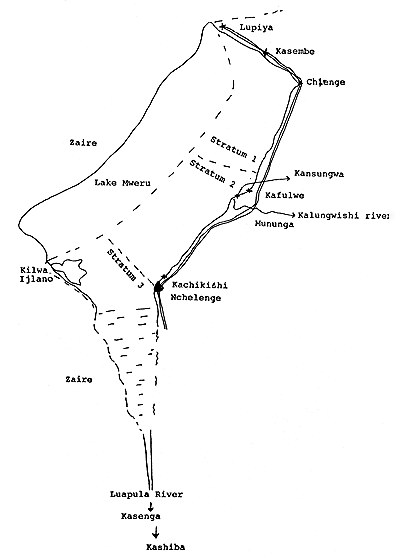The research took place in two fishing villages with connecting fishing camps which were identified as fast-growing areas. The information reported is based on research data and supported by the literature reviewed.
Luapula Province is situated in the high rainfall belt of the Central Africa plateau. Climatically, the year is divided into a dry season (April - November) and a rainy season (December - March).
The land surface area of the Province is 30,600 square kilometres, of which 11,600 is considered arable with mostly sandy soils. The lake, swamps and associated wetlands take up 43.5% of the total available land in Luapula Province. The two major bodies of water are Lake Bangweula in the south-eastern corner and Lake Mweru in the north-western corners of the Province (see map 1). The southern and western boundaries of the Province are defined by the Luapula river which drains Lake Bangweulu and flows into Lake Mweru via a winding channel which widens into a broad swampy river valley for the last 100 kilometres (Gould, 1). The Lake Mweru and Bangweulu fisheries contributed in 1984 more than 40% of the fish marketed in Zambia, while almost half of the total population in the Province is involved in fishing.
Fishing is undertaken not only along the shores of Lake Mweru, but also in the Luapula river valley. The Department of Fisheries divides the lake and river into four strata, taking both the number of fishing camps/villages and their geographical location into consideration (map 2).
According to the frame survey carried out by the Department of Fisheries in 1986 approximately 7,700 fishermen operating 6,600 boats live in stationary fishing villages spread out along the 210 km shoreline.
The northern part of the lake is since the early eighties characterised by chisense fishery and trade. Demersal fishing takes place but on a limited scale. One of the research areas, Kasembe, is situated along this northern coastline (map 2). The west coast of the lake is characterised by a combination of chisense and demersal fishing. The second research area, Kafulwe/Kansungwa, is located 80 km north of Nchelenge along the west coast (map 2).
Lake Mweru area is connected with other parts of the district through the “valley road” from Mansa to Nchelenge and Chiengi up to the Zairean border.
The valley road was asphalted from Mansa to Nchelenge in 1988. Traffic is relatively intensive, with regular bus services and traders plying lorries from the Copperbelt to buy fish. Fish taken to the Copperbelt market is transported along the valley road via Mansa and across the “pedicle” at Chembe through Zaire.
From Nchelenge up north the tarmac ends and a graded road begins. This road has been subjected to heavy use up to Mununga. From this point the road is very bad; most trucks and buses do not use it. Up north, the transport services offered are far fewer, but are increasing since the chisense fishery started (early 1980s). The grading last year has improved this road very much, generating an increase of traffic up north. But the bulk of the produce is still transported via water, mainly to Zaire.
Some of the fishing camps as well as some of the out-grower farm areas east of the main road, like Kansungwa, are not accessible by car, people go there by boat or on foot.
Map 1: Luapula Province, Zambia

Map 2: Lake Mweru -- Strata and Research Areas

Services in the area are good by Luapula standards. The area has quite a few transport services, both by water and road. The regular bus service transports both people and produce to Mansa and the Copperbelt. The Mweru Water Transport Company maintains regular communication to the Kilwa Island twice a week. “Mofwe” transport provides services along the lake and river banks twice a week for cargo and for people going to Lumbumbashi by truck. This is used intensively to transport processed fish and to a lesser extent, farm produce. Several Zairean boats also land along the Zambian coast. All of them collect produce.
Apart from these scheduled services, local boat or truck owners can be hired to transport people or goods. Kansungwa residents can do their shopping in Kafulwe only by walking a long distance or by boat. Several boat/engine owners transport people up and down regularly. Trucks owned by local businessmen are hired by women to transport loads of charcoal from the forest to Kafulwe for sale to fishermen. These services are expensive but they are available.
The Kafulwe residents make use of the Rural Health Centre of Mununga, which is considered very unsatisfactory: it is a long walk and both Mununga and Kafulwe are densely populated. One trained (unpaid) midwife assists numerous traditional midwives. Kasembe residents have access to a nearby clinic and school in Chipungu, and use the Zairean hospital in Mpweto if necessary.
Kafulwe has a primary school, although it is too small and ill-provided. One mission hospital (Kashikishi), 12 Rural Health Centres and 54 schools -- all facing problems with lack of material, transport, etc. -- serve the entire population along the coast.
In Nchelenge town, administrative, police and post office services as well as credit and banking facilities are provided. Credit facilities exist for agriculture and fisheries (Lima bank, ZCF/FS). It was noted that many people are not aware of the facilities. One or two respondents (male) had taken loans to buy an engine. Remarkably enough, the services include fishing nets with mesh sizes that the Department of Fisheries is trying to discourage; credit is given to fishermen staying in the closed “Mifimbo” areas. Extension services are not satisfactory. No agricultural extension officers are posted in research areas; those responsible for these areas have not been very effective. Fisheries extension is limited to sporadic workshops (the last one, on fish conservation, was held last year). A fish scout is posted in Kafulwe, but he is mainly in charge of monitoring activities.
Some areas are very well provided with commodities, ensuring constant traffic between those areas and the Copperbelt and Zaire. Zairean goods are freely available, a reflection of the high level of border trade between Zambia and Zaire.
The developments of the area obviously depend to a large extent on the future of the fishing industry, which in turn depends on management of the fisheries. At least one previously valuable species has become extinct, and one of the larger breams, (Orechromis macrochir), is in danger of extinction. The management and policing of the fisheries depends officially on the Department of Fisheries, who are under-staffed and under-financed, yet do their job effectively.
It is remarkable how little attention has been paid to fisheries in Luapula ever since colonial times. Agriculture has cornered most of the attention. Agricultural extension and research efforts aimed at Nchelenge District have focussed on the production of cash crops such as rice and maize (a national policy) with a conspicuous lack of long-term success (perhaps because it largely overlooks the majority of farmers: the women involved in food crop production.) Donors have paid more attention to agricultural or cooperative development.
In 1986 the World Bank showed interest in rehabilitating the Kashikishi ice-plant. After their withdrawal from Zambia, the idea was taken up by SNV/NDO in 1991. Funded by IFAD, the ice plant is now being rehabilitated and will operate as a private enterprise (Isabi Investment) in which local fishermen can buy shares. The enterprise has a freezing unit, sells ice-flakes, has a wholesale unit and will process mango in the closed fishing season. At the same time, the Department of Fisheries gets strengthened in research (stock assessment, limnological survey), training (boatbuilding, net-making, engine repair) and extension activities (Annex 3).
In research areas, only a few people are aware of the IFAD programme, and only a few (the well-to-do) expect any benefit from them. In general, people feel the Government is letting them down. Both in Kasembe and Kafulwe, people have been crying out without success for a well to increase their access to clean water. In Kafulwe, several efforts have been made to get support for extension of the school. These have partly succeeded: two blocks were built in 1989 but the roofs, doors, etc. are still missing. A building constructed in 1987 by IRDP to serve as a boatbuilding yard has never been put to use. The fishermen's association holds its meetings there, the traders spend the night there. Ideas were put forward to use the building for a hammermill or some other purpose.